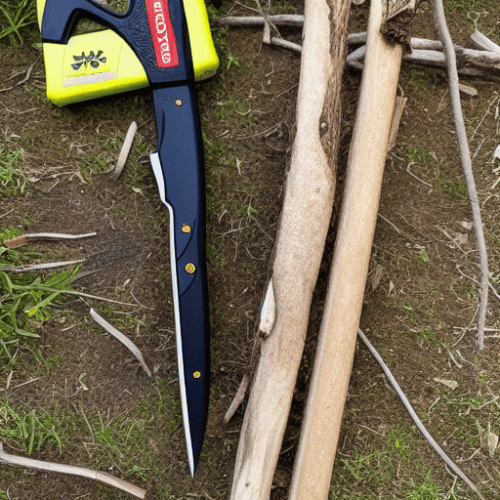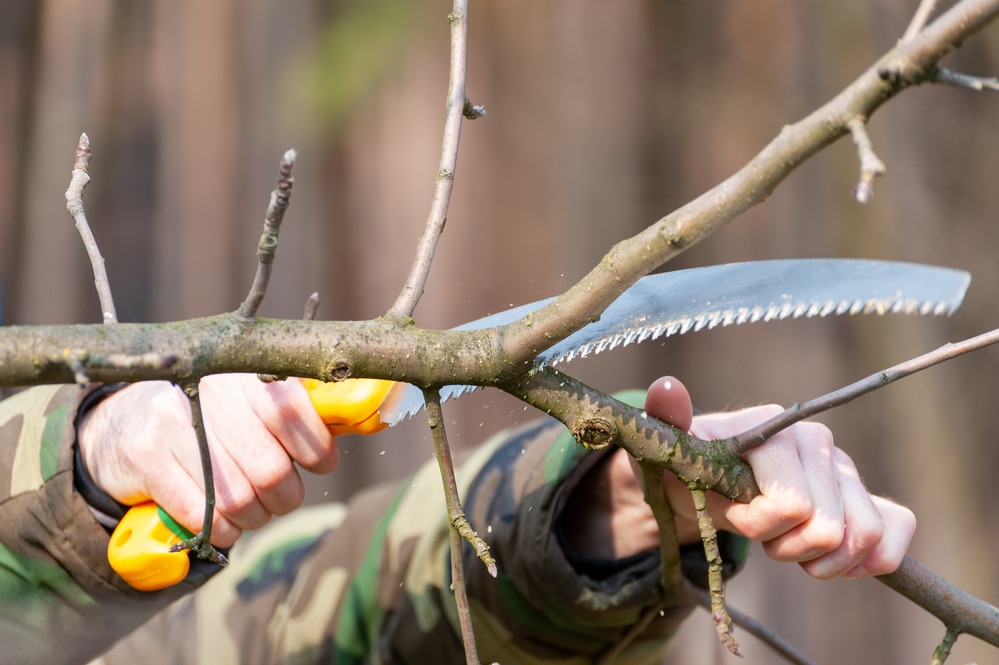Last Updated on
Knowing how to use a tree pruning saw correctly means you will be able to get the most out of this rather basic tool. When it comes to trimming back branches of all sizes, there is no doubt that an efficient pruning saw will become your closest friend, and the fact that a good pruning saw won’t break the bank is simply a bonus.
But then, you need to know how to use the saw correctly. Thankfully, you do not require any specialist knowledge to do so.
The Basics of a Pruning Saw
I just cut down a tree in my backyard with a pruning saw. This scratched up & sweaty city girl is feeling ruggedly accomplished right now.💪 #firsttimeforeverything
— @chouinardphoto@bsky.social (@chouinardphoto) May 23, 2019
Don’t @ me about the tree. It was an unwanted 15’ weed tree.
As the name suggests, a pruning saw will be best used to prune back branches or foliage. In contrast to pruning shears, which are frequently restricted in what they can handle, it is seen to be a more powerful option.
It contains a blade-like other saws, but the teeth on a pruning saw will tend to be longer in nature than you would usually expect on other saws.
These saws have an exceptionally sharp blades, so you need to keep safety in mind at all times, just as you would with any other saw. The blade is also slightly curved, but that will make it easier when dealing with shrubs, a plant, or cutting wood.
Where Would You Use Pruning Saws?
At Weston we believe in teaching our children the skills they need in order to take risks independently. Here is one of our Year 2 children using a pruning saw to cut a branch off of the hazel tree that we use for coppicing #risktaking #riskbenefit #learningoutside #indepedence pic.twitter.com/kJNtowdNtv
— Weston St. Mary Primary School (@WestonStMary) November 30, 2018
When it comes to where you would use pruning saws, then it is primarily with larger branches. In fact, most people would recommend using a pruning saw when cutting branches that are more than 1.5 inches in diameter.
Pruning saws can be used on a healthy limb, and it is also the best option for removing a branch that has been hit by the disease. However, the sharp blade on a pruning saw does make it easier when removing deadwood. That sort of limb can be challenging for shears to deal with, so this saw will make a huge difference.
How to Use a Pruning Saw
So now that you know when to use a pruning saw instead of pruning shears, how do you use it? Well, there are some simple steps that we recommend that you should follow.
Why a Pruning Saw Is Better Than Shears
Channelled my inner lumberjack today and cut down a tree with just a pruning saw. Guessing there will be some sore muscles tomorrow.
— Clarice (@painted_pinkies) August 16, 2014
Shears do have their part to play when pruning in your garden, but they have their limitations. You need a significant amount of strength to cut through a number of branches or stems with shears, and it’s all thanks to how they cut them.
A pruning saw requires less strength. Yes, it may take longer to achieve your desired result, but at least you will achieve it in the first place.
Step By Step Guide On How to Use a Tree Pruning Saw
Step 1: Understand What You Are Pruning
The first step is to know which branch, or branches, you want to cut from the tree. Look at the tree, or the bush, that you will be working on, and determine the pieces of wood that you want to preserve effectively. Having a clear idea in advance makes it easier when you will then try to cut branches.
Step 2: Cut From Top to Bottom
For some reason, over the last two weeks, the man who lives opposite has been selectively "pruning" a large tree of its branches, with an improved very long arm saw. Today it has got stuck. pic.twitter.com/OZ3BZYoLxI
— Nick Wellings (@Nick_Wellings) April 15, 2020
Whenever you try to cut branches, always seek to do so from top to bottom. It is all down to gravity, and it’s also going to be more comfortable. These tools can be awkward to use at certain angles, so anything that changes is welcome.
Step 3: Make Preliminary Cuts
What we mean by preliminary cuts is that thicker branches are heavy, and people can become so focused on simply cutting the tree branches that they do not think about the weight. Instead, you need to take your pruning saw and cut off small branches that come off the main one. It reduces weight.
Take small sections and finally work your way back to your final cut, where the thick branches are finally removed in their entirety.
With cutting, do try to make sure that you have a straight cut.
Step 4: Always Start With a Groove
Trimming a large tree with a pruning saw and breaking/snapping the large branches is hard work.
— kayden (@transpoticket16) July 2, 2020
It’s also good for anger management and stress relief.
I’ll keep it in mind, for future.
🙃🙃🙃
You want as clean a cut as possible, so start by making a groove just as you would with other saws. In this respect, pruning saws are no different, so take the blade and make a few cuts to create that notch. It’s also the case that this means the blade will not slide around when cutting those tree branches, so you get a cleaner cut overall.
Step 5: Starting Your Cut
You must remember that everything happens on the pull stroke with saws, and the pruning saw works in the same way. Focus on that groove, and keep the blade in the groove at all times. Move the pruning saw and allow the blade to cut down into the groove, making it deeper.
Once the groove has grown, you can increase the speed of the tool, and you will start to cut through the branch.
Step 6: When to Add Weight and Pressure
Remember when we just said everything happens on the pull stroke? Well, you need to put more weight and power on the pull stroke to get anywhere. It also means you can pull back more lightly on the push part to save some energy while also preserving the blade.
Step 7: Complete the Cut
To complete the cut of the branch, you need to keep on going with the pruning saw until the blade has gone completely through the branch you are cutting. It may be the case that it breaks off before you complete the cut, but that’s OK.
With this, you may notice that a small part of the branch is left, but you can still deal with that, and pruning saws are perfect. When dealing with this fragment, press the pruning saw flat against the cut and bring it lightly down against the splinter. You will notice it comes off with ease.
Step 8: Repeat the Process
My new toy, a giant pruning saw, for straightening out my ash and oak trees. pic.twitter.com/SVCIID44IH
— Brown Envelope Seeds (@MadsMcKeever) February 2, 2019
All that’s left is for you to repeat the process. Pruning can take some time, depending on the types of pruning you are doing. Take an individual branch or stem at a time, and remember to work to your plan to achieve the finished look you want with the tree or bush.
That’s all you need to do when it comes to knowing how to use a pruning saw. As you can see, it is very easy to do, and the hardest part is going to be working out the branch that should be cut next.
Using a Pole Pruner
But what if you are trying to prune a branch or cut plants where they are higher up off the ground than you can reach? In that case, you need to use a pole pruner to make life easier.
With a pole pruner, pruning saws are attached to the pole, and you then look at using the blades on the saw in the same manner as if you were cutting things by hand.
The main reason for this extension is simply to allow you to reach that branch on the higher-up tree without needing to worry about getting ladders out. It allows the average person to get on with the lower branches of their trees in their garden without needing specialised help.
Pruning Saws Are Wonderful Tools

As tree-cutting tools go, pruning saws are wonderful garden utensils to have at your disposal. There is no better saw for cutting trees than this, as its grip on the branch is second to none.
Remember, the teeth on the blade of these saws are made for this particular job. They will rip through the rough exterior of the branch before working their way through the softer interior of the tree branch.
If you have to carry out pruning regularly, then forget about sticking with scissors or anything else. Invest in pruning saws, and life will become a whole lot easier with those outdoor jobs. Also, remember to get the correct pole if you wish to begin pruning those higher-up branches and don’t want to get out a ladder.
Start Using Your Tree Pruning Saw
Trimming a plant or branch should not be difficult. However, pruning saws will make things safer than they would have otherwise been, so follow the few simple tips we mentioned earlier, and you should be able to complete the job without any problem.
Paul is the type of person who never met a problem he couldn’t fix. He can always be found tinkering with something in his house, even if it isn’t broken! His tips and tricks are often shared on our site. He’s the one you call when something breaks because he has been known to improvise fixes for everything from leaky faucets to malfunctioning dryers.



